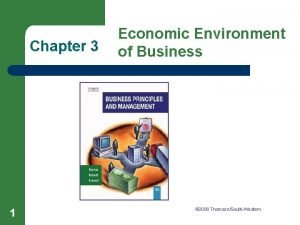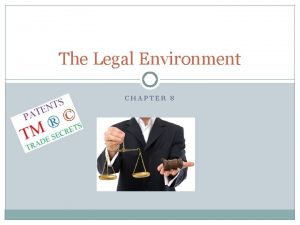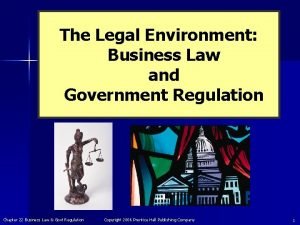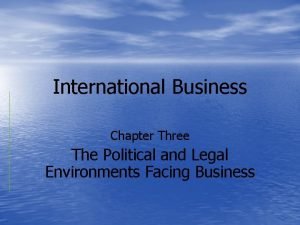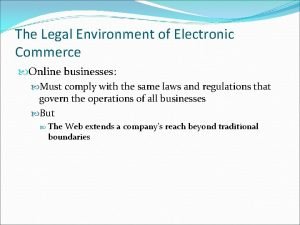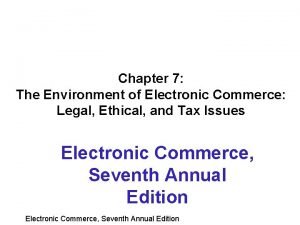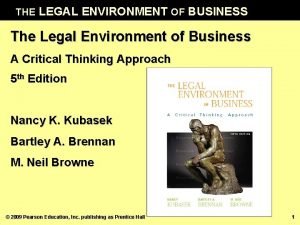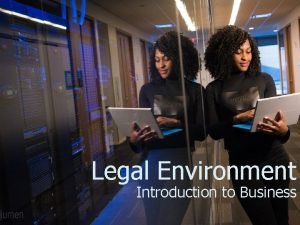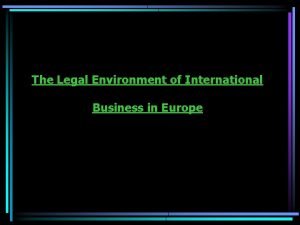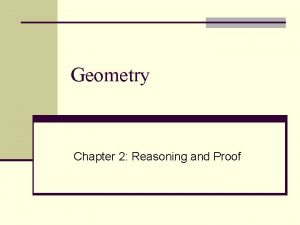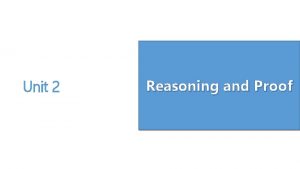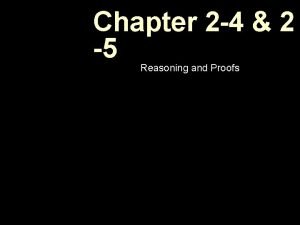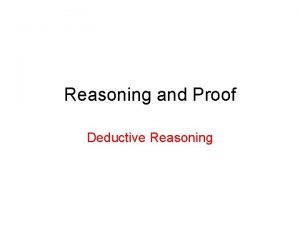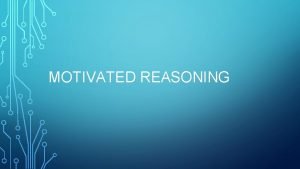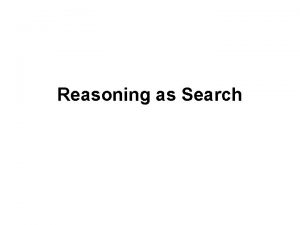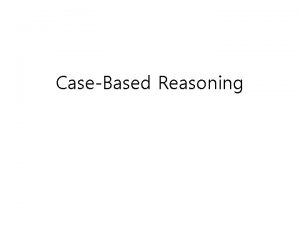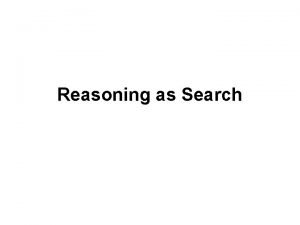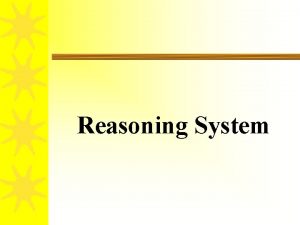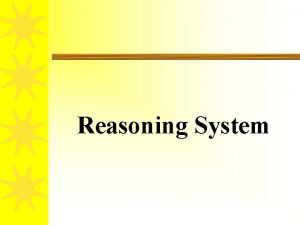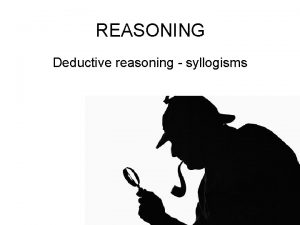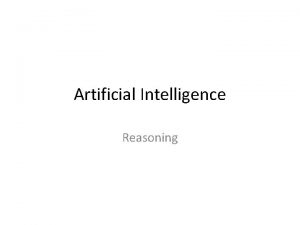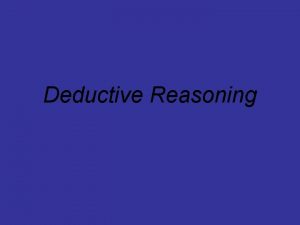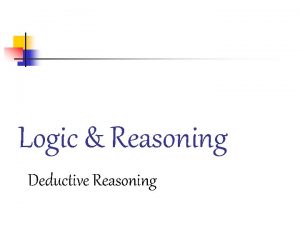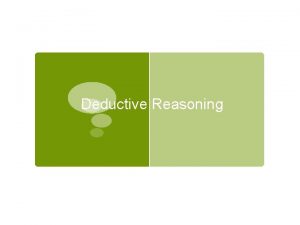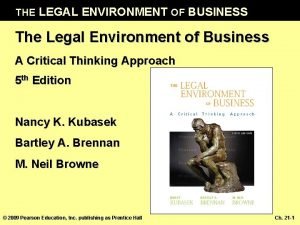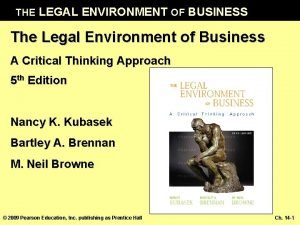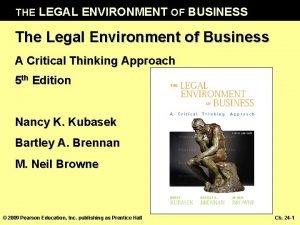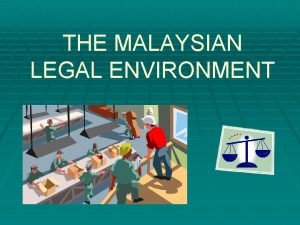Chapter 1 Legal Reasoning and the Legal Environment







![The Common Law Tradition [2] At common law, there were two separate court systems The Common Law Tradition [2] At common law, there were two separate court systems](https://slidetodoc.com/presentation_image_h/1a6903cc3841412f198cdc5276d5fd35/image-8.jpg)














![Reading & Understanding Case Law [2] Legal cases are identified by a “legal citation” Reading & Understanding Case Law [2] Legal cases are identified by a “legal citation”](https://slidetodoc.com/presentation_image_h/1a6903cc3841412f198cdc5276d5fd35/image-23.jpg)
![Reading & Understanding Case Law [3] Legal cases are identified by a “legal citation” Reading & Understanding Case Law [3] Legal cases are identified by a “legal citation”](https://slidetodoc.com/presentation_image_h/1a6903cc3841412f198cdc5276d5fd35/image-24.jpg)
![Reading & Understanding Case Law [4] Legal cases are identified by a “legal citation” Reading & Understanding Case Law [4] Legal cases are identified by a “legal citation”](https://slidetodoc.com/presentation_image_h/1a6903cc3841412f198cdc5276d5fd35/image-25.jpg)


- Slides: 27

Chapter 1: Legal Reasoning and the Legal Environment West’s Business Law Power. Point Slides (8 th Ed. , 2001) 1 © 2001 West Legal Studies in Business. All Rights Reserved.

§ 1: What is Law ? • • Natural Law view. Positivist view. Historical view. Legal Realism view. 2 © 2001 West Legal Studies in Business. All Rights Reserved.

Natural Law • Assumes that law, rights and ethics are based on universal moral principals inherent in nature discoverable through the human reason. • The oldest view of jurisprudence dating back to Aristotle. • Jefferson’s Declaration assumes “the Laws of Nature. ” 3 © 2001 West Legal Studies in Business. All Rights Reserved.

Natural Law Rev. Martin Luther King, Jr. Letter from the Birmingham Jail, April 16, 1963. “[T]here are two types of laws: just and unjust laws. . A just law is a manmade code that squares with the moral law. . An unjust law is a code that is out of harmony with the moral law. . An unjust law is a human law that is not rooted in eternal and natural law. ” 4 © 2001 West Legal Studies in Business. All Rights Reserved.

Legal Positivism • Law is the supreme will of the State that applies only to the citizens of that nation at that time. • Law, and therefore rights and ethics, are not universal. The morality of a law, or whether the law is “bad or good, ” is irrelevant. 5 © 2001 West Legal Studies in Business. All Rights Reserved.

Legal Realism Jurisprudence that holds law is not simply a result of the written law, but a product of the views of judicial decision makers, as well as social, economic, and contextual influences. 6 © 2001 West Legal Studies in Business. All Rights Reserved.

§ 2: The Common Law Tradition American law is based largely on English Common Law which was based largely on traditions, social customs, rules, and cases developed over hundreds of years. 7 © 2001 West Legal Studies in Business. All Rights Reserved.
![The Common Law Tradition 2 At common law there were two separate court systems The Common Law Tradition [2] At common law, there were two separate court systems](https://slidetodoc.com/presentation_image_h/1a6903cc3841412f198cdc5276d5fd35/image-8.jpg)
The Common Law Tradition [2] At common law, there were two separate court systems with two different types of remedies: – COURTS OF LAW (monetary relief), and – COURTS OF EQUITY (non-monetary relief) based on “notions of justice and fair dealing. ” 8 © 2001 West Legal Studies in Business. All Rights Reserved.

Courts of Law • Also called “king’s courts” where judges were appointed by the king. • Remedies limited to those provided at law, i. e. , land, chattel, money. • Judges resolved disputes by application of rules of law to the facts of the case before the court. 9 © 2001 West Legal Studies in Business. All Rights Reserved.

Courts of Equity Also called courts of chancery in Delaware. Equitable relief was sometimes available in instances where a strict application of the law to the facts of the case compelled a result that was legal but unjust. 10 © 2001 West Legal Studies in Business. All Rights Reserved.

Remedies Today • Today federal and state courts of general jurisdiction have consolidated remedies at law and remedies at equity. • Generally, the same court can fashion a remedy that includes both damages and equitable or injunctive relief. 11 © 2001 West Legal Studies in Business. All Rights Reserved.

Stare Decisis Stare decisis is a Latin phrase meaning “to stand on decided cases. ” – Makes the law stable and predictable. – Increases judicial efficiency by relieving courts of having to reinvent legal principles for each case brought before them. 12 © 2001 West Legal Studies in Business. All Rights Reserved.

Stare Decisis and Precedent • Stare decisis is “judge made law” based on precedent. • Precedents are judicial decisions that give rise to legal principles that can be applied in future cases based upon similar facts. • Precedents and other forms of positive law, such as statutes, constitutions, and regulations, are referred to as binding authority and must be followed. 13 © 2001 West Legal Studies in Business. All Rights Reserved.

Cases of “First Impression” In cases of “first impression” where there is no precedent, the court may refer to positive law, public policy, and widely held social values in order to craft the best new precedent. 14 © 2001 West Legal Studies in Business. All Rights Reserved.

Legal Reasoning • Method used by judges to reach a decision. • Many courts and attorneys frame decisions and briefs using the IRAC format: Issue, Rule, Application (Analysis), and Conclusion. • See the Legal Reasoning site. (© Copyright 2000. Lawnerds. com. Used by permission. ) 15 © 2001 West Legal Studies in Business. All Rights Reserved.

Types of Legal Reasoning • Deductive Reasoning: Makes use of syllogism, a type of logical relationship involving a major premise and a minor premise. • Linear Reasoning: Proceeds from point to point, with the final point being the conclusion. • Reasoning by Analogy: Analysis that compares facts of present case with facts of similar previously-decided cases. 16 © 2001 West Legal Studies in Business. All Rights Reserved.

§ 3: Sources of American Law • • • U. S. and State Constitutions. International Treaties. Statutory Law--federal and state. Administrative Regulations and Decisions. Restatements of the Law (ALI). Case Law and Common Law Doctrines. 17 © 2001 West Legal Studies in Business. All Rights Reserved.

§ 4: Classifications of Law Every type of law will be either: – Civil or Criminal, and either – Substantive or Procedural, and either – Public or Private. 18 © 2001 West Legal Studies in Business. All Rights Reserved.

Civil vs. Criminal • Civil law defines the rights between individuals or individuals and governments. • Criminal law defines an individual’s obligations to society as a whole. 19 © 2001 West Legal Studies in Business. All Rights Reserved.

Substantive vs. Procedural • Substantive law defines or creates the rights and obligations of persons and governments. • Procedural law provides the steps one must follow in order to avail oneself of one’s legal rights or enforce another’s legal obligations. 20 © 2001 West Legal Studies in Business. All Rights Reserved.

§ 5: Finding Primary Sources of Law • Finding Statutory Law. – United States Code (USC). – State Statutes (Texas). • Finding Administrative Law. – Code of Federal Regulations (CFR). • Finding Case Law (Case Citations). – Supreme Court Cases at Findlaw. com. – Federal Court Cases at Findlaw. com. – State Court Cases at Findlaw. com. 21 © 2001 West Legal Studies in Business. All Rights Reserved.

§ 6: Reading & Understanding Case Law Legal cases are identified by a “legal citation” (or a “cite”) as the example below: Federal Express Corp. v. Federal Espresso, Inc. , 201 F. 3 d 168 (2 nd Cir. 2000). Title: First Party is Plaintiff, second party is Defendant. The parties are either italicized or underlined. 22 © 2001 West Legal Studies in Business. All Rights Reserved.
![Reading Understanding Case Law 2 Legal cases are identified by a legal citation Reading & Understanding Case Law [2] Legal cases are identified by a “legal citation”](https://slidetodoc.com/presentation_image_h/1a6903cc3841412f198cdc5276d5fd35/image-23.jpg)
Reading & Understanding Case Law [2] Legal cases are identified by a “legal citation” (or a “cite”) as the example below: Federal Express Corp. v. Federal Espresso, Inc. , 201 F. 3 d 168 (2 nd Cir. 2000). Case is found in volume 201 of the 3 rd Federal Supplement, page 168. 23 © 2001 West Legal Studies in Business. All Rights Reserved.
![Reading Understanding Case Law 3 Legal cases are identified by a legal citation Reading & Understanding Case Law [3] Legal cases are identified by a “legal citation”](https://slidetodoc.com/presentation_image_h/1a6903cc3841412f198cdc5276d5fd35/image-24.jpg)
Reading & Understanding Case Law [3] Legal cases are identified by a “legal citation” (or a “cite”) as the example below: Federal Express Corp. v. Federal Espresso, Inc. , 201 F. 3 d 168 (2 nd Cir. 2000). Case was decided by the United States Second Circuit Court of Appeals in 2000. 24 © 2001 West Legal Studies in Business. All Rights Reserved.
![Reading Understanding Case Law 4 Legal cases are identified by a legal citation Reading & Understanding Case Law [4] Legal cases are identified by a “legal citation”](https://slidetodoc.com/presentation_image_h/1a6903cc3841412f198cdc5276d5fd35/image-25.jpg)
Reading & Understanding Case Law [4] Legal cases are identified by a “legal citation” (or a “cite”) as the example below: Federal Express Corp. v. Federal Espresso, Inc. , 201 F. 3 d 168 (2 nd Cir. 2000). Read this Case at Findlaw. com by clicking on the hyperlink. 25 © 2001 West Legal Studies in Business. All Rights Reserved.

§ 7: Businesspersons and the Law • Laws regulate all areas of business. • Factors business owners must consider: – Is contract enforceable? – Contract for goods vs. services? – What happens if someone breaches the contract? – Dispute Resolution? 26 © 2001 West Legal Studies in Business. All Rights Reserved.

Law on the Web • Findlaw. com. • Legal Information Institute at Cornell Law School. • Library of Congress. • Villanova Center for Law and Policy. • Reading Legal Citations (© 2000 Lawnerds. com. Used by permission. ) • Legal Research Exercises on the Web. 27 © 2001 West Legal Studies in Business. All Rights Reserved.
 Deductive logic definition
Deductive logic definition Deductive and inductive arguments
Deductive and inductive arguments The legal environment of business chapter 3 problem 7bcp
The legal environment of business chapter 3 problem 7bcp The legal environment of business chapter 8 problem 5bcp
The legal environment of business chapter 8 problem 5bcp Legal environment of business chapter 1
Legal environment of business chapter 1 Deductive reasoning vs inductive reasoning
Deductive reasoning vs inductive reasoning Example of deductive reasoning
Example of deductive reasoning Deductive vs inductive
Deductive vs inductive Every quiz has been easy. therefore the quiz will be easy
Every quiz has been easy. therefore the quiz will be easy Patterns and inductive reasoning
Patterns and inductive reasoning Government regulation and the legal environment of business
Government regulation and the legal environment of business Legal and ethical environment of business
Legal and ethical environment of business Political and legal environment facing business
Political and legal environment facing business Financial environment in business environment
Financial environment in business environment The legal environment of electronic commerce
The legal environment of electronic commerce Legal environment in e commerce
Legal environment in e commerce Legal environment definition
Legal environment definition Legal environment definition
Legal environment definition Legal environment of international business
Legal environment of international business Course 2 chapter 1 ratios and proportional reasoning
Course 2 chapter 1 ratios and proportional reasoning Chapter 2 reasoning and proof
Chapter 2 reasoning and proof Unit 2 logic and proof inductive reasoning
Unit 2 logic and proof inductive reasoning Chapter 2 reasoning and proof answer key
Chapter 2 reasoning and proof answer key Hình ảnh bộ gõ cơ thể búng tay
Hình ảnh bộ gõ cơ thể búng tay Frameset trong html5
Frameset trong html5 Bổ thể
Bổ thể Tỉ lệ cơ thể trẻ em
Tỉ lệ cơ thể trẻ em Voi kéo gỗ như thế nào
Voi kéo gỗ như thế nào


